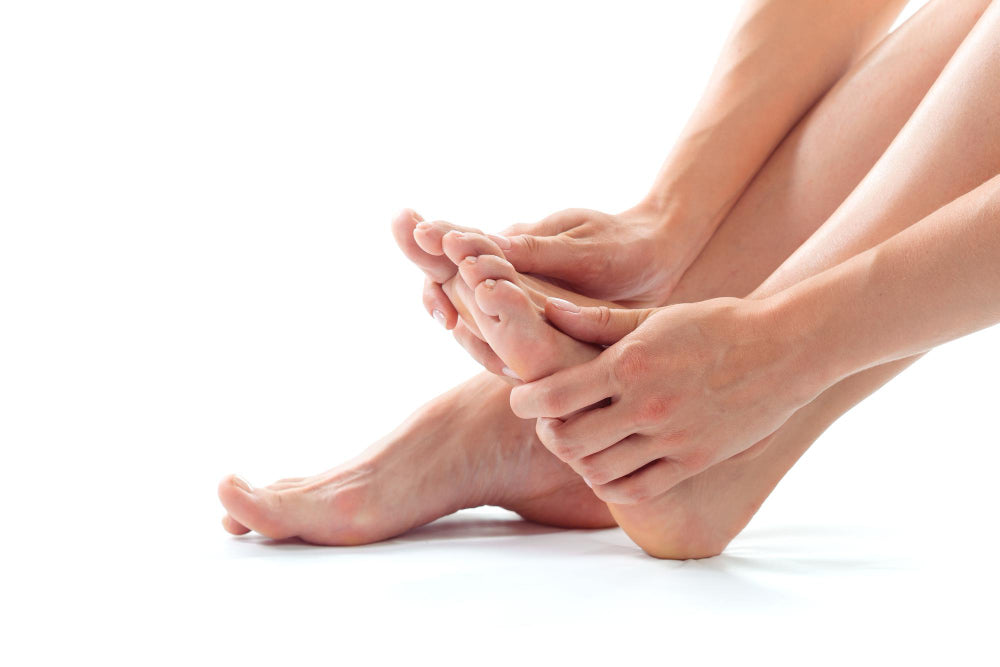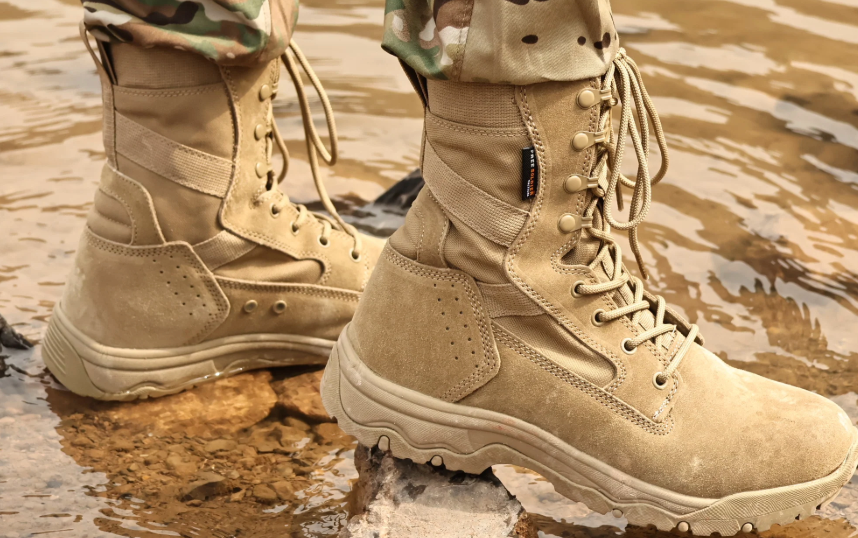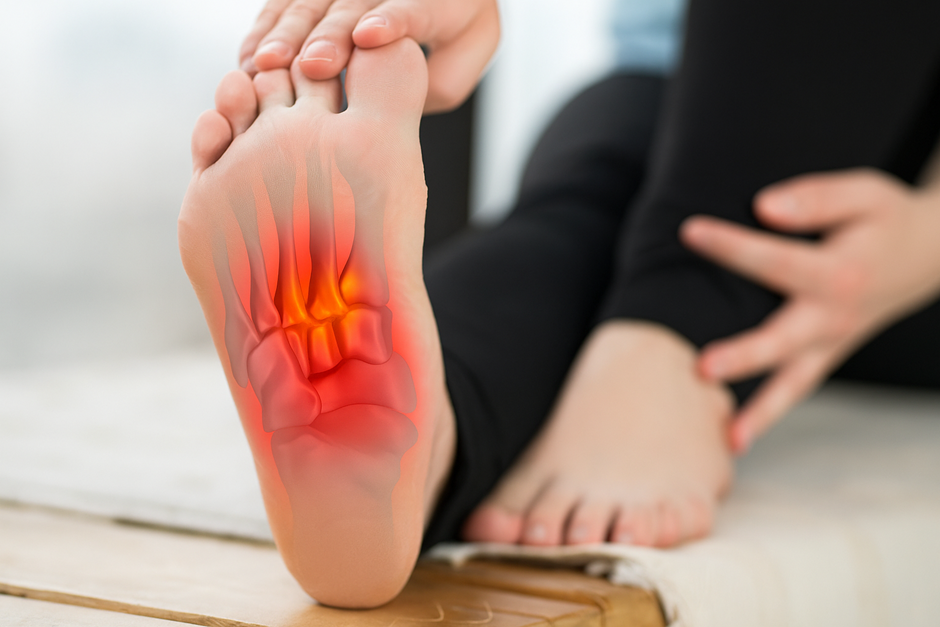What Causes Pain on Top of Foot?
Pain on top of foot can be caused by a number of different factors including: extensor tendonitis, stress fractures, midfoot arthritis, gout or pseudogout, nerve compression, ganglion cyst, infections, sinus tarsi syndrome, vascular problems, referred pain, impact injury, and improper footwear.
In this article, we will be discussing these possible causes in detail so that you can easily identify what may be the cause of pain on the top of the foot. This information is important because once you identify the exact cause, solving it becomes easier.
Let’s start looking into these possible causes before you have to decide if you need custom orthotics.
Extensor Tendonitis
The extensor tendons, which comprises of the EHL (Extensor Hallucis Longus) and the EDL (Extensor Digitorum Longus), is a group of tendons that run from the lower leg, through the ankle to the toes.
These tendons, which are responsible for dorsiflexion (lifting the toes and foot up), can easily get compressed, overused, irritated, and exposed to trauma and other circumstances that can get them inflamed. When this happens, the condition is referred to as Extensor Tendonitis and it can cause pain on the top of the foot.
Common reasons why they get inflamed include:
· Overuse and repetitive stress from activities like running, high-intensity sports, hiking etc.
· Foot conditions such as high arches, flat feet, tight calf muscles and even poor walking or running form
· Improper footwear - shoes with poor arch support or tight-fitting shoes that compress the tendons
· Direct trauma like an heavy object falling on the top of the foot
· Health conditions such as psoriatic or rheumatoid arthritis
Stress Fractures
These are small cracks that occur in the foot. The most commonly affected bones are the second and third metatarsals. As you will expect, these tiny cracks result in sharp pains that are specific to the location of the cracks and it gets worse when weight is put on the affected foot.
You may find the area slightly swollen and tender to touch. There may also be some bruising and the pain will usually get worse as you keep the foot active.
Factors that contribute to its occurrence include:
· Skeletal disorders like osteoporosis that result in low bone density
· Repetitive stress brought about by activities like running, dancing, and suddenly increased high-impact activities
· Biomechanical conditions like high arches and flat feet
Midfoot Arthritis
This is the inflammation or degeneration of the joints connecting the bones of the midfoot to the forefoot and the hindfoot. These joints, which include the TMT (Tarsometatarsal) joints and intertarsal joints like the intercuneiform and the naviculocuneiform joints, can become so affected that cartilages between them wear down so much so that bone-to-bone contact ensues, resulting in inflammation and pain.
Common causes of this condition include:
· Wear and tear from aging (Osteoarthritis)
· Overuse or repetitive stress, especially with folks dealing with conditions like flat foot or irregular gait
· Post-traumatic arthritis from previous injuries to the joints
· Rheumatoid arthritis and other conditions that result in inflammation in the joints
· Obesity which increases the stress that the joints are exposed to
Gout or Pseudogout
These are types of arthritis caused by the deposit of crystals in the joints. These sharp crystals cause sudden inflammation which results in sudden sharp pains. The joints in the foot often affected are the metatarsophalangeal (MTP) or tarsometatarsal (TMT) joints.
While both gout and pseudogout are caused by the sudden formation of crystals in the joints, the types of crystals differ for each case.
For gout, the crystals are formed from uric acid while for pseudogout, the crystals are formed from calcium pyrophosphate.
Causes of this condition include:
· For gout, increase in levels of uric acid in the blood due to increased alcohol intake, consumption of red meat or shellfish, kidneys diseases or dehydration
· For pseudogout, a buildup of calcium pyrophosphate in the joints which can be caused by trauma or injury to the joints, aging, or an underlying health condition
Nerve Compression
This condition occurs when the nerves are compressed, squeezed or pinched by the exertion of undue pressure on them. On the top of the foot, the nerves commonly affected are the superficial peroneal nerve which send sensation to the top of the foot and the deep peroneal nerve which sends sensation to the space between the big toe and second toe and also supplies motor functions to the extensor muscles.
When these nerves are compressed, you can experience a burning, sharp pain. You can also experience numbness or tingling.
Some common factors that can lead to nerve compression include:
· Tight-fitting footwear
· Swelling or direct trauma
· Foot conditions like flat feet and high arches
· Repetitive strain like in running and cycling
· Peripheral neuropathy which amplifies compression symptoms by sensitizing the nerves
Ganglion Cyst
These are sacs filled with fluid that can develop from a tendon sheath of joint capsule found on the top of the foot. Though this growth is benign, it often causes discomfort and pain mainly because of the pressure it exerts on surrounding structures. The exact size and location of the sacs will therefore determine how painful and uncomfortable it will be.
The main cause of this condition is not as yet fully known. However, certain factors are thought to contribute to its growth and they include:
· Irritation of the joints or tendons from repetitive stress or other microtrauma to the joints
· Abnormal foot conditions like high arches and flat feet that increase stress on the joints of the midfoot
· Pre-existing conditions like osteoarthritis or previous Lisfranc injuries
Infections
One can experience a lot of pain on the top of the foot as a result of fungal, bacterial, or even viral infections. These infections which can either be superficial or deep, can affect the skin, tissues, and even the skeletal structures of the foot.
Some common causes include:
· Bacterial infections like celluitis, abscess, osteomyelitis, and septic arthritis
· Fungal infections like tinea pedis (athlete's foot), and deep fungal infections
· Viral infections, though quite rare, some like HSV (Herpes Simplex Virus) and VSV (Varicella-Zoster Virus) can result in painful lesions
Sinus Tarsi Syndrome
This is not a direct pain or condition on the top of the foot but one that radiates to it from the sinus tarsi, a small canal located between the calcaneus and the talus. If there's injury to this canal or it gets inflamed, the pain from it will radiate to the top of the foot. This type of pain on th etop of the foot is also known as “Referred Pain.”
Some of the common causes of this condition include:
· Ankle sprain with inversion ankle sprain being the most common cause
· Trauma or damage to the soft tissues in the sinus tarsi, resulting in inflammation
· Joint instability from previous strains that causes constant irritation to the sinus tarsi
· Inflammatory conditions like rheumatoid arthritis
· Repetitive stress like jumping, running and even standing for long on an uneven surface
Vascular Problems
Vascular problems that result in pain on the top of the foot can be caused by poor blood supply to the foot (arterial insufficiency), poor blood flow from the foot (venous congestion), or inflammation of the blood vessels (dorsalis pedis artery, dorsal vein or other smaller vessels). Aside from pain, they can also cause tissue damage.
Some common causes of this condition include:
· Peripheral Arterial Disease – PAD resulting from atherosclerosis which narrows the walls of the dorsalis pedis or posterior tibial arteries slowing the flow of blood
· Venous Insufficiency from either valve dysfunction in the dorsal veins which can lead to blood pooling and even Deep Vein Thrombosis (DVT)
· Vasculitis - inflammatory conditions that affect blood vessels, resulting in pain and possible tissue damage
· Compression or trauma from external pressures like tight-fitting footwear
Impact Injury
Impact injuries can happen in various forms. It can be a heavy object falling on the top of the foot, causing fractures in the bones, hurting the tendons, nerves or the blood vessels. Or it can be the foot hitting against a hard object, hurting the structures in the top of the foot.
Common examples include:
· Heavy object falling on the foot
· The foot making forceful contact with a hard surface
· Sports accidents
· Falls of vehicular accidents
Improper Footwear
Footwear that are poorly designed, tight-fitting, and lacking in adequate support can increase the risk of pain on the top of the foot. They can compress or increase the stress exerted on the different structures located on the top of the foot. These include the extensor tendons, nerves, and blood vessels.
Such compression and increased stress can lead to nerve compression, and tendonitis, all of which can cause inflammation and pain.
Common footwear that can cause this condition include:
· High heels because they force the foot into an unnatural position
· Footwear without sufficient toe box
· Footwear without proper arch support, shock absorption or stabilization
· Shoes that are worn out
· Wrong size of shoes (too small)
· Occupation or fashion shoes that designed for specific functions like steel-toed boots, minimalist sneakers, shoes with pointed toes
Conclusion
We’ve taken some time to discuss several factors that can cause pain on the top of the foot. While the list may not be considered exhaustive, it has covered a wide range of common factors that may be responsible for pain on the top of the foot.
With this guide, you can begin to compare your symptoms to identify the cause of the pain you feel on the top of your foot. If you want to find out how to treat the pain depending on the cause, then you will want to read our guide on how to get rid of pain on top of foot where you will find tips to help you get rid of the pain.




